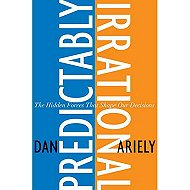|
Predictably Irrational: The Hidden Forces That Shape Our Decisions
|
|
Dan Ariely
|

|

• Why do our headaches persist after taking a one-cent aspirin but disappear when we take 50-cent aspirin?
• Why does recalling the Ten Commandments reduce our tendency to lie, even when we couldn't possibly be caught?
• Why do we splurge on a lavish meal but cut coupons to save 25 cents on a can of soup?
• Why do we go back for second helpings at the unlimited buffet, even when our stomachs are already full?
• And how did we ever start spending 4.15$ on a cup of coffee when, just a few years ago, we used to pay less than a dollar?
When it comes to making decisions in our lives, we think we're in control. We think we're making smart, rational choices. But are we?
In a series of illuminating, often surprising experiments, MIT behavioral economist Dan Ariely refutes the common assumption that we behave in fundamentally rational ways. Blending everyday experience with groundbreaking research. Ariely explains how expectations, emotions, social norms, and other invisible, seemingly illogical forces skew our reasoning abilities.
Not only do we make astonishingly simple mistakes every day, but we make the same types of mistakes, Ariely discovers. We consistently overpay, underestimate, and procrastinate. We fail to understand the profound effects of our emotions on what we want, and we overvalue what we already own. Yet these misguided behaviors are neither random nor senseless. They're systematic and predictable – making us predictably irrational.
From drinking coffee to losing weight, from buying a car to choosing a romantic partner, Ariely explains how to break through these systematic patterns of thought to make better decisions. […]
Dan Ariely is the Alfred P. Sloan Professor of Behavioral Economics at MIT, where he holds a joint appointment between MIT's Media Laboratory and the Sloan School of Management. He is also a researcher at the Federal Reserve Bank of Boston and a visiting professor at Duke University.[…]
His work has been featured in leading scholarly journals and a variety of popular media outlets, including the New York Times, theWall Street Journal, the Washington Post the Boston Globe, Scientific American,and Science.[…]
He divides his time between Durham, North Carolina, Cambridge, Massachusetts, and the rest of the world.
|
|
